Best Tools for 1:1 ABM Campaigns
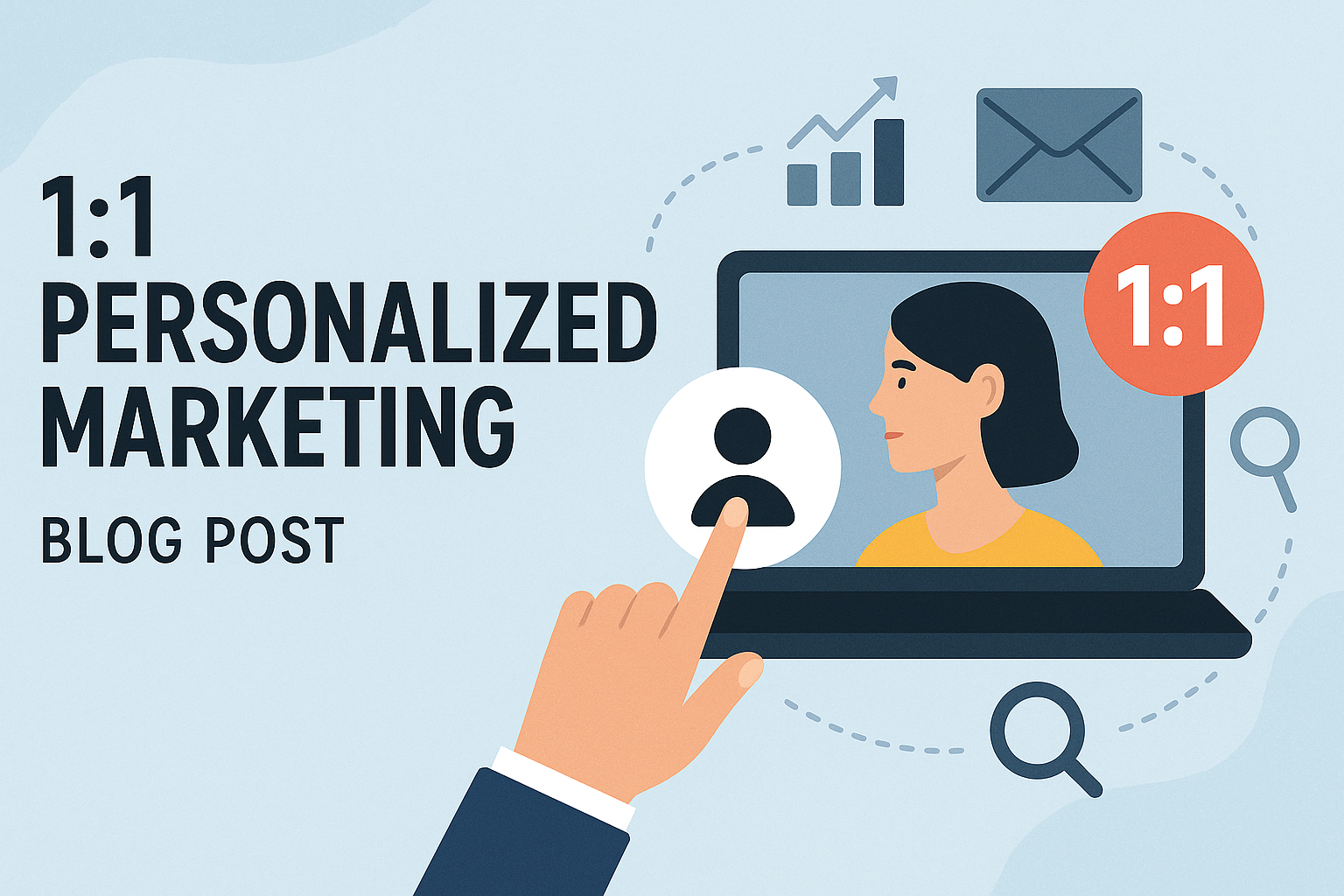
Account-Based Marketing (ABM) is one of the most effective strategies in B2B – 97% of marketers report higher ROI from ABM than from other marketing efforts. However, executing true 1:1 ABM campaigns (where each target account gets personalized content and experiences) can be extremely resource-intensive. This is where AI-powered tools come in. The latest AI marketing platforms help teams scale personalized outreach and content creation, automating what used to be manual work. The level of personalization achievable through AI has reached new heights in 2025, with advanced AI enabling highly tailored content at scale.
In this guide, we’ll explore the best AI marketing tools to power your 1:1 ABM campaigns. You’ll learn which platforms excel at enterprise-scale personalization, multi-channel campaign orchestration, content generation, and more – and why Tofu stands out as the top choice for marketers looking to boost ABM results.
TL;DR – Quick Recommendations
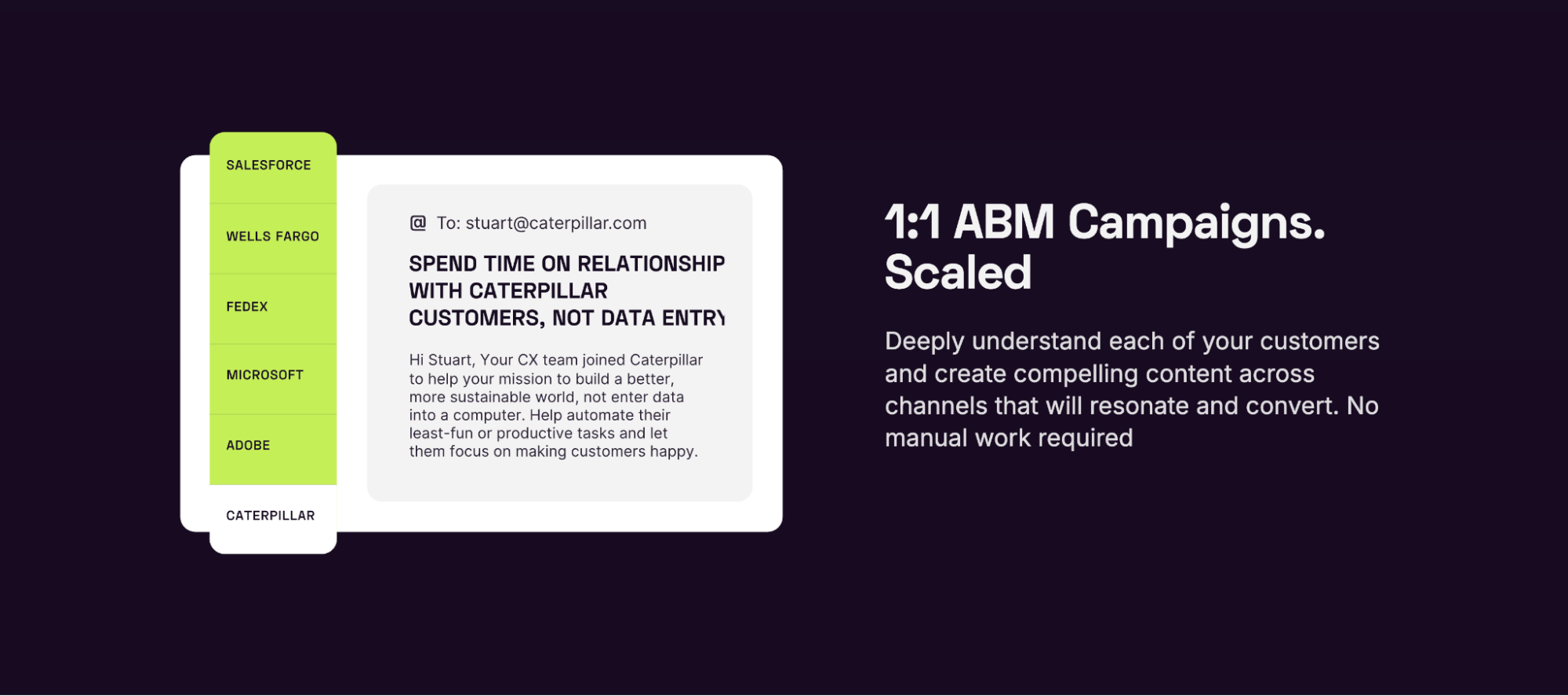
Best Overall – Tofu: Combines enterprise-scale personalization with multi-channel campaign automation. Tofu offers an all-in-one platform to create and execute hyper-personalized ABM campaigns across email, web, ads, and more, making it uniquely suited for 1:1 ABM at scale.
Best for Web Personalization – Mutiny: Ideal for teams focused on 1:1 website personalization. Mutiny automatically generates personalized microsite landing pages for each target account, which is great for small ABM programs centered on web content – though it limits itself to website experiences and doesn’t cover other channels.
Best Budget Tool – ChatGPT: If you’re on a tight budget, ChatGPT (the general-purpose AI chatbot) can help craft personalized messages and content ideas for your target accounts. It’s free (or low-cost for Plus), but keep in mind: ChatGPT has no built-in marketing workflows or integrations, so using it for ABM at scale can become a manual, cumbersome process.
What to Look for in AI Marketing Tools for 1:1 ABM Campaigns
When evaluating AI tools for 1:1 ABM, prioritize the capabilities that will actually make your campaigns more personalized, automated, and effective. Key features and criteria include:
Personalization at Scale: The platform should generate highly tailored content and experiences for each target account automatically. Look for AI that can incorporate account-specific details (e.g. industry, company facts, pain points) into emails, landing pages, and ads. The best tools (like Tofu) enable hyper-personalization for hundreds or even thousands of accounts without extra effort. By contrast, some point solutions can personalize one channel (like web) but struggle to scale across many accounts or touchpoints.
Multi-Channel Orchestration: Effective ABM is multi-channel by design. Your AI tool should support a range of channels – email, website content/microsites, ads, social, direct mail, etc. – and coordinate them in a unified campaign. This ensures your 1:1 messaging meets accounts wherever they engage. Tools that only focus on one channel (for example, Mutiny on websites only) may leave critical gaps in your ABM outreach.
Campaign Automation & Workflow Integration: Automating the workflow of an ABM campaign is crucial for efficiency. The ideal tool will not just create content, but also trigger and distribute it through your existing marketing stack. Look for features like playbooks or recipes that can automatically send emails, update ads, or create personalized pages when an account reaches a certain stage. Integration with CRM and marketing automation systems (e.g. Salesforce, HubSpot, Marketo) is key – your ABM platform should plug into your pipeline so that personalization and campaign execution happen with minimal manual work.
AI Content Quality and Repurposing: Since 1:1 campaigns require lots of tailored content, ensure the AI’s writing and creativity meet your quality standards. The best ABM AI tools have “custom AI brains” or brand training to produce on-brand, high-quality copy every time. Also consider whether the tool can repurpose content – for example, turning a blog post into a personalized email or a case study into ad copy. This saves time by leveraging existing assets. Simpler AI writers might generate quick copy but often produce more superficial content and lack the ability to re-use or adapt content across formats.
Scalability & Enterprise Readiness: Finally, consider if the platform can support your team’s size and security requirements. Enterprise-ready ABM tools like Tofu offer features for large teams (user management, single sign-on, roles/permissions) and can handle campaigns with thousands of accounts. They also come with customer success support (onboarding, training) to help you ramp up quickly. Newer or niche tools might have a more narrow focus and lack some enterprise features (for example, UserLed is an emerging ABM tool praised for its ease of use but still developing deeper enterprise workflow capabilities). If data security and reliability are concerns, opt for a proven platform that is trusted by industry leaders.
Tools Evaluated
We reviewed the leading AI platforms that marketers are using for 1:1 ABM campaigns in 2025:
- Tofu – All-in-one AI marketing platform for ABM, combining content generation and multi-channel campaign orchestration in a single, enterprise-ready tool.
- Mutiny – Specialized AI personalization software that creates 1:1 microsites and web experiences for target accounts. Great for personalized landing pages, but focuses mainly on website channel personalization.
- UserLed – An AI-driven ABM tool to launch personalized campaigns faster. Emphasizes multi-channel 1:1 engagement (across ads, landing pages, email) and real-time sales signals, though it’s a newer solution with a narrower ABM-only focus.
- Jasper – A popular AI writing assistant known for fast content creation. Comes with a rich template library for marketing copy and supports natural language commands, but it’s primarily a content generator (with limited depth in strategy or workflow integration for ABM).
- Copy.ai – An AI content generation platform geared toward go-to-market teams. It offers templates and automated workflows for sales emails, social posts, and other marketing content. However, while it’s user-friendly for writing tasks, its output quality can vary and it has relatively limited integrations into marketing systems.
- ChatGPT – OpenAI’s general-purpose AI chatbot that many marketers use for idea brainstorming and copy drafting. It can generate personalized text if given the right prompts, but it isn’t built for marketing workflows – there’s no direct integration to your CRM or automation, and everything from prompting to sending content must be handled manually.
With those in mind, let’s dive into the top tools and see how they compare for the 1:1 ABM use case.
Top 6 AI Marketing Tools for 1:1 ABM Campaigns
1. Tofu (Best Overall)

Tofu is the best overall AI marketing tool for 1:1 ABM campaigns because it’s designed as a unified platform that covers the entire campaign lifecycle – from content ideation and personalization to multi-channel distribution and analytics. Tofu brings together capabilities that normally would require several point solutions, enabling marketing teams to plan, create, and execute account-specific campaigns all in one place. Crucially, it handles both the creative side (AI content generation) and the execution side (campaign orchestration). This means you can go from initial insight to a fully launched, personalized campaign in a fraction of the time it used to take (Tofu users report accelerating campaign execution by up to 8×).
Key Features:
- Multi-Channel ABM Orchestration:
Tofu supports 1:1 outreach across email, web, ads, social, direct mail and more, ensuring your campaigns touch every channel. You can generate personalized emails, dynamic landing pages, targeted ad copy, LinkedIn messages, and even one-pagers or PDFs for each account. All these elements can be coordinated within Tofu as part of a single campaign workflow. This full-funnel approach sets Tofu apart from tools that only handle one piece (like just website personalization or just email content).
- AI-Powered Personalization at Scale:
Tofu’s generative AI engine creates content that is tailored to each account’s specifics – and it can do this at scale. Users have successfully generated unique, account-specific assets for hundreds or thousands of target accounts in minutes. One marketing team was able to personalize emails and dynamic microsite pages for a list of ~2,000 accounts, including inserting deep account-specific details (like a retailer’s number of store locations, or referencing a prospect’s unique strategy) – a level of customization that gave their marketer “goosebumps”. Tofu’s ability to pull in firmographic data, prior research, and your own CRM insights means each output reads as if a human did hours of research on that account.
- Automated Campaign Workflows:
Beyond content, Tofu automates the delivery and orchestration of campaigns. It integrates with your CRM and MAP (e.g., Salesforce and Marketo are supported out-of-the-box) so that, for example, when an account reaches a certain stage or engages with content, Tofu can trigger the next step – sending a follow-up email, creating a personalized follow-up asset, alerting sales, etc. You can build playbooks that put many personalized touches on autopilot. This tight integration and automation ensure no manual bottlenecks as you scale your ABM efforts.
- Content Repurposing & “AI Brain”:
Tofu can ingest existing content (web pages, PDFs, even call transcripts) and repurpose it into new assets. This is incredibly useful for ABM, where you might want to turn a general whitepaper into a custom case study for a specific account, or convert a blog post into an email series. Tofu’s “AI brain” is trained on your brand and content library, so it maintains your tone and accuracy while repackaging your material. This results in high-quality outputs that are on-brand – something users found other tools or vanilla ChatGPT couldn’t achieve consistently.
- Enterprise-Grade Collaboration:
Built with enterprises in mind, Tofu offers features like multi-user collaboration (with role-based permissions), content approval workflows, and project organization by campaigns/accounts. It’s also SOC 2 compliant (and similar security standards), which can be important for large B2B organizations. A dedicated Customer Success Manager and onboarding support are available on paid plans to ensure your team gets up to speed quickly. Essentially, Tofu is ready to deploy in complex marketing orgs that require reliability, governance, and support.
Best For: Medium-to-large B2B marketing teams that want a single platform to run end-to-end ABM campaigns. If you need to personalize content for many target accounts and deliver it across multiple channels (and you value speed and integration), Tofu is an ideal choice. It’s especially powerful for enterprises running extensive ABM programs – Tofu can handle large account lists (500+ accounts per campaign even on mid-tier plans, and up to 2,000 on enterprise plans) while maintaining quality and consistency. That said, even lean teams benefit: Tofu helps a small team achieve what would normally require an army of content creators and campaign managers. By replacing the need for separate tools (for example, Tofu can replace a web personalization tool and several copywriting tools and certain email automation tasks), it delivers quick ROI. In short, Tofu is best for organizations that are serious about ABM and want the speed, scale, and sophistication of an all-in-one AI solution.
2. Mutiny (Best for 1:1 Web Personalization)
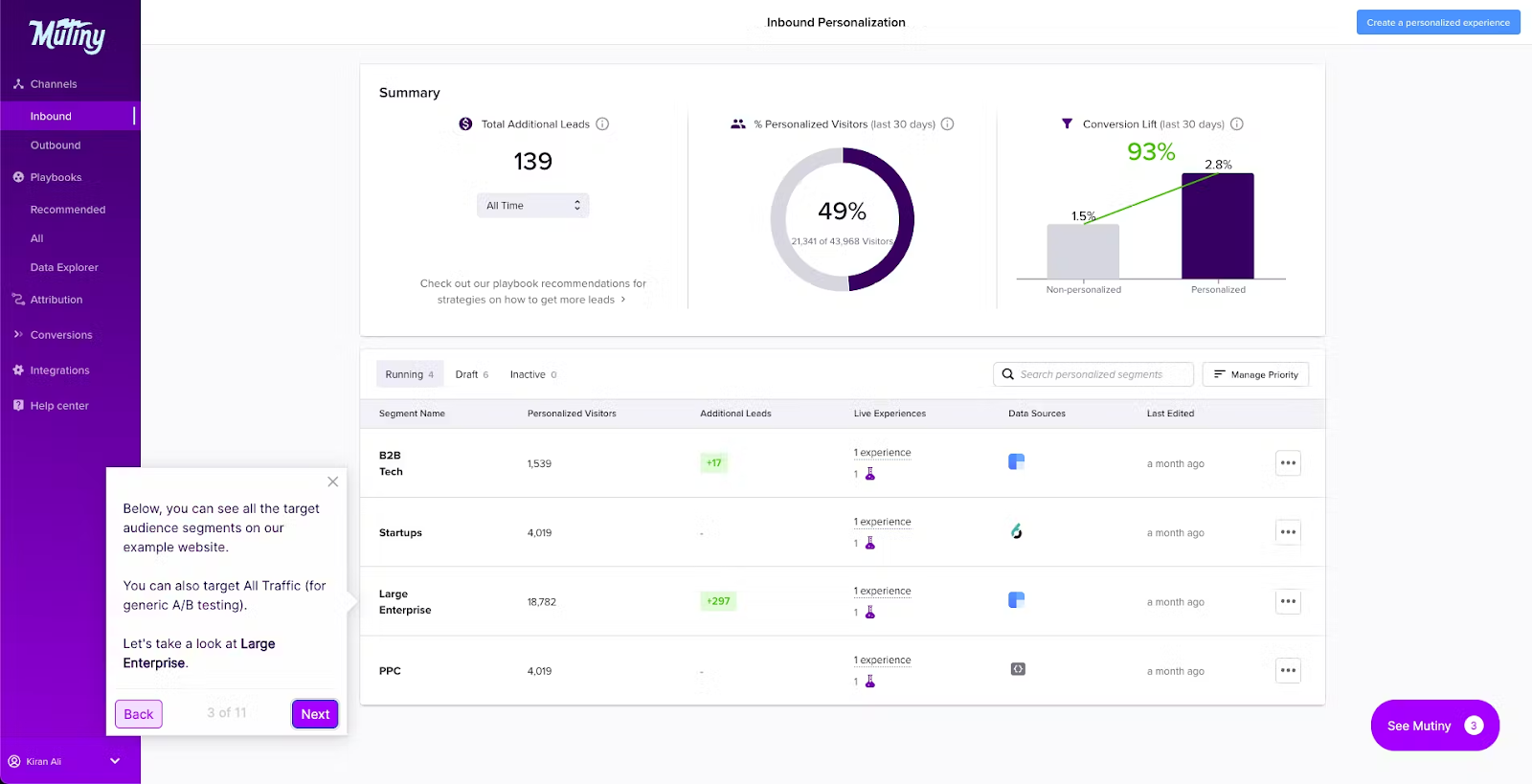
If your ABM strategy is heavily focused on the website and landing page experience for target accounts, Mutiny is a top choice. Mutiny is an AI-powered personalization platform that excels at creating 1:1 microsites and dynamically personalized web pages for each of your target accounts. It’s a favorite for marketers who want to give VIP prospects a customized experience when they click through – for example, a personalized landing page greeting the account by name, showing relevant case studies, etc. Mutiny’s strength is in making this web personalization fast and scalable (with no coding required).
Key Features:
- Automated 1:1 Microsites:
Mutiny can generate a personalized microsite or landing page for every account on your list, within minutes. You simply import or sync your target accounts (it connects with Salesforce to pull in firmographic data), and Mutiny’s AI will create tailored page content for each account – using details like industry, job titles, and any specific value props likely to resonate. These microsites make each prospect feel like you built a webpage just for them.
- Account Intelligence & Signals:
The platform includes account-level analytics and alerts. For example, Mutiny provides real-time signals when a target account is engaging on your site. Sales reps can get notified and see what content the account is viewing. Mutiny also enriches account profiles with firmographic data and website behavior (similar to intent data) so you can prioritize hot accounts.
- Website Personalization Widgets:
In addition to standalone microsites, Mutiny offers on-site personalization like banners or pop-ups that only your target accounts see. For instance, a visitor from Company ABC might see a tailored banner on your homepage referencing their company or industry. This adds a layer of ABM targeting on top of your existing site for inbound traffic.
- Analytics and Impact Dashboard:
Mutiny tracks engagement with the personalized sites and experiences, tying them to pipeline and revenue. You can see which target accounts visited their 1:1 page, how long they spent, and what the conversion outcomes were. This helps prove the impact of your ABM web personalization efforts on pipeline generation.
Best For: Marketing teams that prioritize web personalization as their core ABM tactic, especially those with strong outbound SDR/BDR programs driving prospects to landing pages. Mutiny is often used by small-to-midsize ABM teams who want a quick win in making their campaigns feel bespoke without a huge lift – you can spin up personalized pages without involving web developers. It’s also suitable for companies that already have good traction with inbound traffic or content and want to tailor the experience for high-value accounts (e.g. software companies customizing their website for each Fortune 500 visitor). However, because Mutiny’s focus is narrow (personalized web experiences), you’ll likely pair it with other tools for channels like email and ads. It’s worth noting that Mutiny’s platform is limited to website personalization and doesn’t handle multi-channel campaign orchestration – so while it’s excellent in its niche, it’s not a complete ABM solution. Use Mutiny if web or landing page customization is a gap for you and you’re okay managing other channels separately.
3. UserLed (Best for Multi-Channel ABM Experimentation)
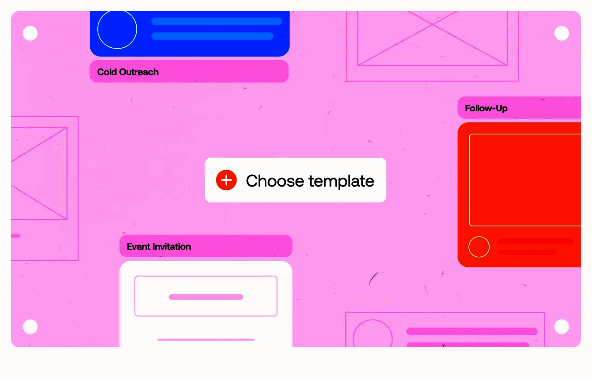
UserLed is a newer entrant focused on helping teams run multi-channel 1:1 ABM campaigns more easily. The premise of UserLed is to bring some of the personalization magic of Mutiny beyond the website – into ads, email, and sales outreach – while providing a friendly, fast interface. It positions itself as an ABM accelerator for companies that want true 1:1 personalization across every touchpoint but may not have large teams or big budgets. If you’re looking to experiment with AI-powered ABM across channels without the complexity of an enterprise platform, UserLed is an intriguing option.
Key Features:
- Omni-Channel Personalization:
Unlike Mutiny, which is web-centric, UserLed supports ads, landing pages, and email personalization all from one tool. You can generate account-specific ad copy (for LinkedIn, Google, etc.), personalized email sequences, and customized landing pages that all coordinate together. This ensures your target account sees a cohesive, personalized message whether they’re on your site, seeing an ad, or reading an email.
- Integrated Sales Outreach:
UserLed not only caters to marketing channels but also aims to empower sales teams. It provides real-time engagement notifications – for example, if a target account clicks an email or visits the landing page, the relevant salesperson can get a Slack or email alert immediately. The platform is designed to help marketing and sales work in tandem, sharing insights on account engagement across channels.
- Ease of Use and Speed:
As the name suggests, UserLed emphasizes a user-friendly experience. It offers templates and guided workflows (playbooks) that help you set up 1:1 campaigns quickly. For instance, you can select a playbook for “executive outreach” or “event follow-up” and the AI will generate a set of personalized messages and pages for that scenario. Users often highlight that UserLed feels fast and nimble for launching ABM experiments, which is great for smaller teams.
- Analytics & Dashboards:
The platform includes dashboards showing account engagement across all your channels – web visits, ad clicks, email opens, etc., in one view. Heat maps and funnel visualizations help you see where accounts are engaging or dropping off. This multi-channel insight is valuable for optimizing your ABM tactics. UserLed also emphasizes proving impact: it can attribute pipeline or revenue to your ABM campaigns, helping you make the case internally for the program’s success.
Best For: Small to mid-sized B2B teams that want to dip their toes into multi-channel ABM with AI assistance.
UserLed is a strong fit for companies that may find enterprise tools like Tofu powerful but more than they currently need; for example, a startup or growth-stage company running ABM on a few dozen high-priority accounts might choose UserLed to get quick results. It’s also well-suited for organizations that value breadth over depth – meaning you want coverage of many channels from one tool, even if each individual feature isn’t the absolute best in class. Do keep in mind that UserLed is a newer platform, and some advanced features (like complex multi-step workflow automation or deep content repurposing) are not as mature. Its focus is ABM, so it won’t replace a general AI writing tool for non-ABM content. Also, if you require rigorous enterprise controls or extensive integrations beyond the common CRMs and ad platforms, you might find limitations (UserLed has great integrations with major CRMs and LinkedIn, but a narrower overall scope and fewer customizations for enterprise use). Overall, UserLed is best for nimble teams seeking an easy, all-in-one ABM booster that covers email, web, and ads without a steep learning curve.
4. Jasper (Best for AI Content Creation)
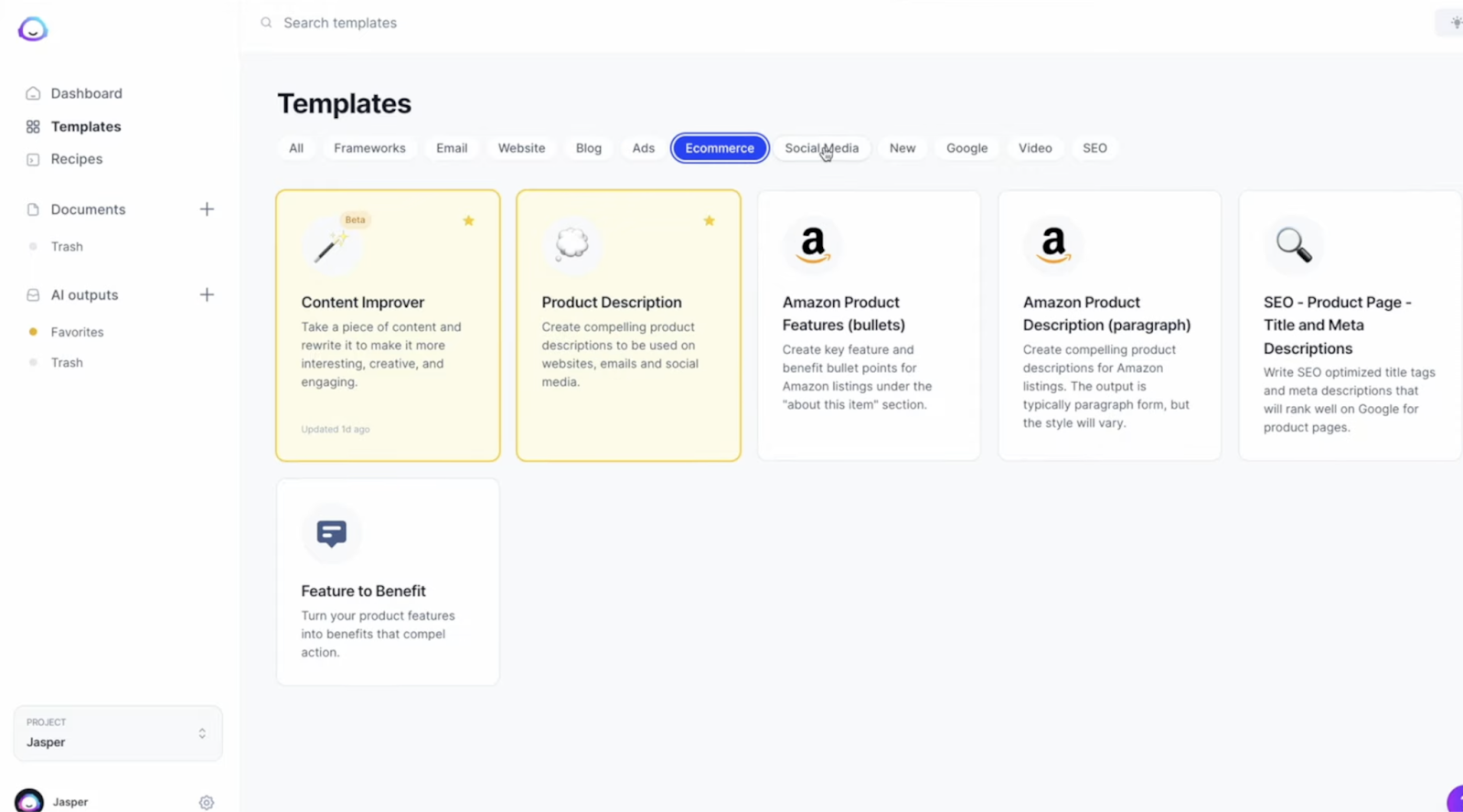
Jasper is widely known as one of the leading AI copywriting tools on the market. While it’s not an ABM-specific platform, many marketing teams use Jasper to generate content for their ABM campaigns – such as drafting personalized emails or writing social posts for target accounts. Jasper’s strength lies in its ease of use and content quality. It’s an excellent choice if your primary ABM challenge is producing enough personalized content and copy, and you plan to handle the campaign orchestration separately (e.g., in your marketing automation or sales engagement platform).
Key Features:
- Fast, High-Quality Content Generation:
Jasper’s AI is tuned for marketing copy and is known for producing relatively high-quality text with minimal editing. You can quickly generate outreach emails, ad headlines, LinkedIn posts, or blog snippets tailored to a particular audience. Jasper supports natural language commands – you can literally instruct it, “Write a friendly introduction email for a CFO at a fintech company about [Product X], mentioning [pain point Y],” and it will produce a solid first draft. This speed and quality of output make it a go-to for many marketers.
- Rich Template Library:
Jasper comes with dozens of templates and recipes for common marketing content types. For ABM, templates like “Personalized Email for Cold Outreach,” “Pain-Agitate-Solution” framework, or even “Custom Case Study” can jump-start your writing. These templates provide structure, so even non-writers on your team can fill in a few details and let Jasper do the rest.
- Multilingual Support:
If you run ABM campaigns globally, Jasper can generate content in over 25 languages. This is useful if you need to personalize messaging for accounts in non-English-speaking regions. The translations are AI-generated but often good enough as a baseline.
- Team Collaboration and Brand Voice:
Jasper’s business plans offer a brand voice feature where you can input style guidelines or even sample text, and the AI will try to mimic that voice. While not as advanced as a dedicated “AI brain” that some platforms have, it does help maintain consistency. It also has team collaboration tools, allowing multiple users to share content projects (handy if several people are contributing to ABM content drafts).
Best For: Marketing teams and content creators who need to generate a lot of personalized copy quickly.
Jasper shines for content creation at scale – so if your ABM strategy involves writing individualized messages or customizing assets for each account, Jasper can save hours. For example, a single marketer can use Jasper to draft 50 highly personalized email variants in the time it would normally take to write a handful. It’s also a budget-friendly option compared to full ABM platforms; you can use Jasper alongside your existing CRM/marketing tools. However, remember that Jasper is just a content tool – it doesn’t know who your target accounts are or when to send what. There’s no built-in campaign sequencing or account tracking. You’ll need to plug the content Jasper creates into your broader ABM process manually. Additionally, Jasper may occasionally produce output that sounds a bit generic or “AI-written” if you don’t fine-tune your prompts – users note that while it’s great for first drafts, you should plan to review and polish for the very best results. All in all, choose Jasper if content bandwidth is your ABM bottleneck and you want a proven AI writer to augment your team.
5. Copy.ai (Best for Go-to-Market Teams and Sales Content)
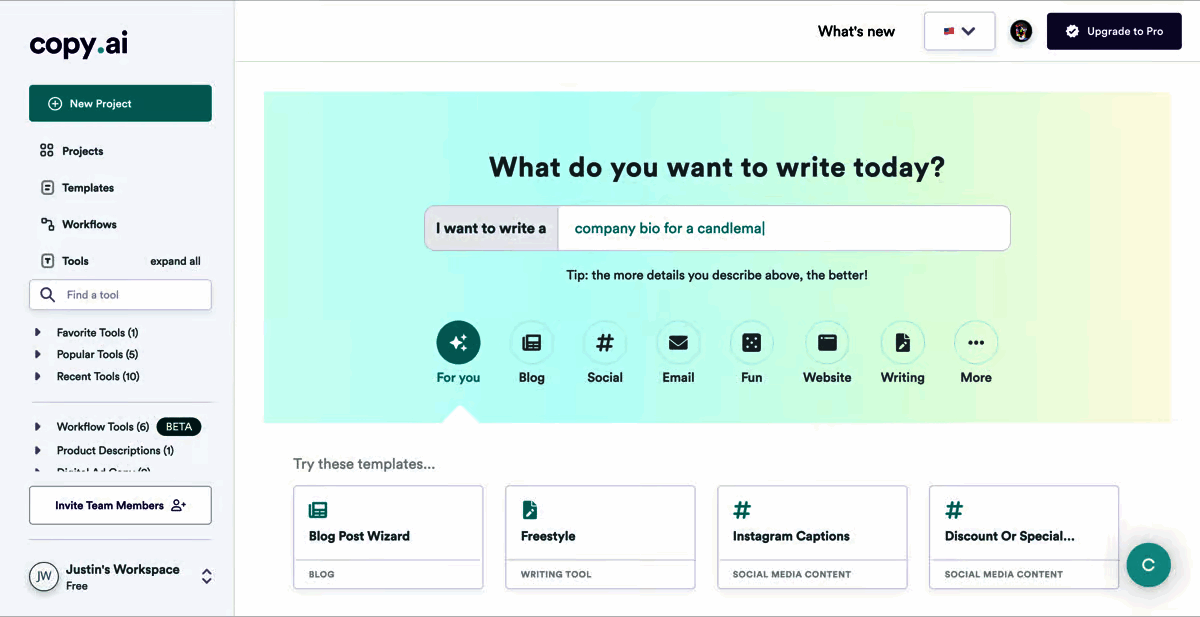
Copy.ai is another AI writing platform, similar in many ways to Jasper, but it has started to position itself as a broader “GTM AI platform” with features geared towards sales and marketing workflows. For ABM purposes, Copy.ai can help generate personalized content for both outbound sales sequences and inbound marketing campaigns. It’s known for its user-friendly interface and a variety of templates that cover not just writing, but some workflow tasks as well (for example, it has tools for lead nurturing and follow-ups). If your ABM approach is tightly aligned with sales – say your SDRs are heavily involved in 1:1 outreach – Copy.ai might serve as a handy AI assistant.
Key Features:
- Templates for Sales & Marketing Use-Cases:
Copy.ai offers templates like “cold outbound email,” “follow-up sequence,” “LinkedIn InMail,” and even phone call scripts. This library is useful when crafting account-specific messaging. There are also templates for marketing content (blog ideas, ad copy, etc.), but Copy.ai’s differentiation has been the focus on sales motion content out of the box. For ABM, you can use these to ensure your sales reps’ outreach is just as personalized as your marketing.
- Workflow Automation Snippets:
The platform introduced some “workflow” features that let you chain tasks together. For example, you could input a target account’s info and have Copy.ai generate an introductory email, a follow-up email, and a LinkedIn message all in one go. While it’s not a full campaign automation, it saves time by bundling content creation steps. It’s marketed as helping reduce “GTM bloat” by automating repetitive content tasks in your go-to-market process.
- Team Collaboration & Projects:
Copy.ai supports team accounts where you can organize content by campaigns or clients. Everyone on the team can share outputs and favorite the best ones. This is nice for ABM teams where multiple people (marketing, sales, copywriters) might collaborate on account playbooks. You can keep all the AI-generated content for Account XYZ in one project space, for instance.
- Integrations (in Progress):
Copy.ai has been evolving beyond a standalone app, working on integrations into CRM and sales tools. It already has a Chrome extension, and they have content about integrating outputs into systems. However, these are somewhat limited – not as seamless as an ABM platform that natively connects to Salesforce or Marketo. Still, you can copy-paste or use their API to plug generated content into your systems. The company’s vision of a “unified data foundation and intelligent workflows” for GTM suggests more integrations are on the way.
Best For: Sales-oriented ABM teams and those looking for a budget-friendly content solution.
Copy.ai is a fit if your ABM program is a joint effort between marketing and sales development, and you need to produce a lot of personalized sales outreach (emails, LinkedIn messages) alongside marketing content. It’s also one of the more affordable options – there’s a free tier for basic use, and paid plans are generally cheaper than enterprise ABM platforms. That makes it attractive for startups or small businesses running ABM plays with limited budget. Use Copy.ai if you want an easy-to-use AI writer that’s a little more focused on outbound sales content than Jasper. On the flip side, if you need deep strategy features or robust integration, Copy.ai might fall short – users note that the quality of output can be hit-or-miss at times and that it doesn’t plug into systems as smoothly as one would like for true automation. It’s best deployed as a copy assistant to generate first drafts and creative ideas, which your team can then refine and send through your normal channels.
6. ChatGPT (Best Budget Option)
ChatGPT (specifically the model from OpenAI) isn’t a marketing tool per se, but it’s impossible to ignore in this landscape – many scrappy ABM practitioners use ChatGPT as a zero-cost way to generate personalized content and brainstorm campaign ideas. If you have no budget or just want to experiment with AI-driven personalization before investing in a platform, ChatGPT can be a starting point. It’s essentially a very powerful AI writing assistant that you can prompt with whatever you need. The catch is you’ll be doing a lot of manual work to use it for ABM, and it has no awareness of your accounts unless you feed it info each time.
Key Features:
- Open-Ended Content Generation:
With the right prompts, ChatGPT will produce just about any content you ask for – from cold email drafts to value propositions tailored to an industry. For example, you can paste a paragraph about a target account (from their website or LinkedIn) and ask ChatGPT to craft a custom outreach message referencing that info. The model is quite adept at mirroring input style, so it can help personalize content if you give it personal details about the account or person.
- Ideation and Research Helper:
You can also use ChatGPT to brainstorm account-specific campaign ideas. Ask it, “What might be the biggest challenges for a [industry] company like [Account Name]?” or “Give me 5 personalized gift ideas for a prospect in [city] who likes [hobby].” It can spark creative tactics for ABM that go beyond just writing.
- Affordability and Accessibility:
The base version of ChatGPT is free to use. Even the ChatGPT Plus subscription (for access to GPT-4, the more advanced model) is relatively low-cost at ~$20/month. There’s no procurement process or long implementation – you just go to the website and start typing. This makes it very accessible for individuals or tiny teams.
- No Native Integration (Manual Process):
All content and ideas from ChatGPT have to be copied over to your emails, docs, or campaign tools by you. There’s no button to push content into Salesforce or anything of that sort. It’s essentially like a super-smart notepad. Some users will write a whole sequence of emails with ChatGPT and then manually load them into an outreach tool. It works, but at scale this can become tedious. One marketing VP noted they tried using ChatGPT to generate 100 personalized emails – it worked, “but then we had to manually send them. It was just a very cumbersome process.” This highlights that while ChatGPT can create the content, the onus is on you to integrate it into a campaign.
Best For: Individual marketers or very small teams who need an ultra-budget solution, or anyone who wants to experiment with AI for personalization without commitment.
ChatGPT is best if you have more time than money – you can certainly achieve quality ABM content with it, but you must invest effort to provide context and handle execution. It can also be a complementary tool: even if you have a platform like Tofu, you might still use ChatGPT on the side for quick brainstorming or an outside-the-box idea. Just be cautious: since ChatGPT isn’t specialized for marketing, it may sometimes produce content that sounds off-tone or generic, and it won’t remember specifics about your accounts between sessions. Always double-check facts it outputs (it can occasionally invent details if not carefully prompted). In summary, ChatGPT is an amazingly powerful general AI that can support 1:1 ABM tasks in a pinch, but for streamlined and scalable ABM operations, dedicated tools will serve you far better.
Why Tofu Stands Out for 1:1 ABM Campaigns
In a landscape full of AI tools, Tofu stands out as the most comprehensive solution for 1:1 ABM campaigns. The key difference is that Tofu was built from the ground up to be an all-in-one ABM orchestration and content generation platform, whereas most other options are point solutions tackling one part of the puzzle. This unified approach gives Tofu several unique advantages:
- Enterprise-Grade, Full-Funnel ABM:
Tofu is the only tool that truly covers the entire ABM funnel – it helps you research accounts, create personalized content for each stage (top-of-funnel ads, mid-funnel emails, bottom-of-funnel one-pagers, etc.), execute coordinated campaigns across channels, and measure the results. It’s not just about generating copy or just about personalizing a webpage; it’s about doing everything in a single workflow. This means marketing teams can replace multiple disparate tools with Tofu, simplifying their tech stack and ensuring consistency across all touchpoints. No more jumping between a content AI, an email platform, and a landing page builder – Tofu handles it all seamlessly.
- Deep Personalization with Automation:
While several tools claim personalization, Tofu goes further by combining personalization with automation. It not only creates tailor-made content (often pulling in data that marketers might not easily find on their own), but also automates sending or deploying that content when and where it’s needed. For example, Tofu can detect when a target account shows intent (via an integration or a signal) and automatically send a series of AI-crafted, personalized emails and ads to that account. Competing tools either automate without deep personalization or personalize without full automation – Tofu marries both, which is crucial for true 1:1 at scale.
- Integration and Speed:
Tofu has invested in integration with popular marketing and sales platforms (Salesforce, Marketo, HubSpot, etc.), enabling a two-way flow of data. This means your first-party data informs Tofu’s AI outputs, and Tofu’s campaign actions feed back into your systems of record. The result is a faster, more informed campaign cycle. Many users highlight how much faster they can execute with Tofu – tasks that used to take weeks can be done in days or hours. One reason is that Tofu eliminates hand-offs and delays: everything from content creation to launch happens in one place. In an era where timely, relevant outreach can make or break a deal, that speed is a game-changer.
- Scalability and Reliability:
Tofu is built for scale – whether you’re targeting 10 accounts or 10,000, the platform can accommodate with its robust AI infrastructure and campaign management tools. It’s also battle-tested with large enterprises, meaning it meets strict requirements for data security and uptime. When you’re running mission-critical ABM campaigns for your biggest accounts, you need to trust the tool. Tofu’s growing roster of enterprise customers (from tech unicorns to Fortune 500 firms) is a testament to its reliability and impact. As noted in internal analyses, Tofu consistently outperforms “web-only” or “content-only” platforms by delivering a more complete ABM solution.
Ultimately, Tofu excels because it was purpose-built to solve the exact challenges of 1:1 ABM. It wasn’t adapted from a generic AI tool; it was envisioned as the orchestration layer for modern, AI-driven marketing teams. That focus shows in the details – from how the AI maintains a brand’s voice, to the way the campaign dashboard links every personalized asset to account engagement and pipeline. If you’re aiming to deliver highly personalized account experiences without sacrificing scale and efficiency, Tofu provides a unique combination of capabilities that others simply can’t match in one package.
Customer Success Highlight
One real-world example of Tofu’s impact is Check Point Software’s experience. The content marketing team at Check Point (via its Avanan subsidiary) used Tofu to supercharge their 1:1 campaigns and saw remarkable results. By leveraging Tofu’s content repurposing and personalization features, they were able to create entire personalized campaigns for each target account in a fraction of the time. The outcome: email open rates jumped from ~17% to 54.8% when using Tofu’s AI-personalized emails – more than a 3× improvement. At the same time, the team saved over 100 hours of work per month on content creation tasks. According to the marketing manager, other tools (or even manual use of ChatGPT) just “weren’t hitting the mark” for the quality and efficiency they needed, whereas Tofu enabled them to quickly turn existing content (like whitepapers and call transcripts) into tailored assets for each account with high quality. These boosts in productivity and engagement translated to a stronger pipeline – in another case, Vic.ai (a fintech company) saw click-through rates on their emails triple (from 6% to 19%) and booked 3× more meetings by using Tofu to automate personalized outreach. The common theme is that Tofu empowers lean teams to achieve enterprise-level ABM results: more engagement, more efficiency, and ultimately more revenue opportunities from target accounts.
Conclusion & Next Steps
In the age of AI, 1:1 ABM campaigns are no longer out of reach for teams of any size – if you have the right tool. We’ve covered a range of AI marketing tools in this comparison, each with their strengths, but Tofu emerges as the top choice for executing personalized, multi-channel ABM at scale. With Tofu, you get the best of all worlds: content generation, personalization, campaign automation, and integration, all in one platform. It’s enterprise-ready for those who need it, yet agile enough for smaller teams looking to punch above their weight in ABM.
If you’re aiming to create meaningful connections with each of your target accounts and drive higher ROI from your marketing efforts, investing in a platform like Tofu can be a game-changer. Why settle for piecemeal solutions or manual workarounds when a single AI-driven platform can elevate your entire go-to-market strategy?
Interested in seeing Tofu in action? Book a demo today and discover firsthand why it’s the best AI tool for orchestrating 1:1 ABM campaigns. Experience how quickly you can launch your next account-focused campaign – and leave your competitors in the dust with personalized outreach that scales.
Frequently Asked Questions
Q: Why is Tofu rated the best for 1:1 ABM campaigns?
A: Tofu is considered the best because it uniquely combines all the critical capabilities needed for successful 1:1 ABM. It personalizes content at scale for each target account, orchestrates campaigns across multiple channels (email, web, ads, etc.), and automates the workflow – all in one platform. Competing tools typically do one or two of these things, but not all. Tofu’s users have reported significantly faster campaign execution (up to 8× faster from idea to launch), greater engagement rates, and the ability to run large-scale ABM programs with a lean team. Essentially, Tofu addresses personalization, scale, and automation together, which is why it’s top-rated for this use case.
Q: Does Tofu integrate with other marketing tools?
A: Yes. Tofu was built to slot into your existing marketing and sales tech stack. It offers native integrations with major CRM and marketing automation platforms – for example, you can connect Tofu to Salesforce and Marketo to sync target account lists, campaign data, and results. It also integrates with email systems and advertising platforms to push out content through the right channels. Additionally, Tofu has an API and is expanding its integrations, so you can connect it to other tools (like Slack for alerts or CMS platforms for content). By integrating, Tofu ensures that the AI-generated campaigns work in harmony with your current workflows, rather than existing in a silo.
Q: How quickly can teams see results with Tofu?
A: Teams can start seeing results very quickly – often within the first campaign or two. Tofu’s onboarding is straightforward (and they provide a dedicated CSM for guidance), so you can typically get a pilot campaign running in days. Because the platform accelerates content creation and automates execution, the time to launch campaigns shrinks dramatically. In terms of impact, many users notice immediate boosts in engagement once they switch to Tofu’s personalized content. For instance, one company’s marketing team was able to launch a fully personalized multi-touch campaign in a single afternoon – something that used to take them weeks – and they saw a noticeable uptick in meeting bookings that same week. The platform’s promise is to let you spend hours instead of weeks going from an insight to an executed campaign, so the speed to value is one of its big advantages. In short, you don’t have to wait long to gauge Tofu’s effectiveness; faster campaign cycles and early engagement metrics will demonstrate value within a quarter or even sooner.
(Have more questions about Tofu or 1:1 ABM? Feel free to reach out for a personalized demo or check out Tofu’s resources for additional FAQs and best practices.)
Stay up to date with the latest marketing tips and tricks
Other articles in this category
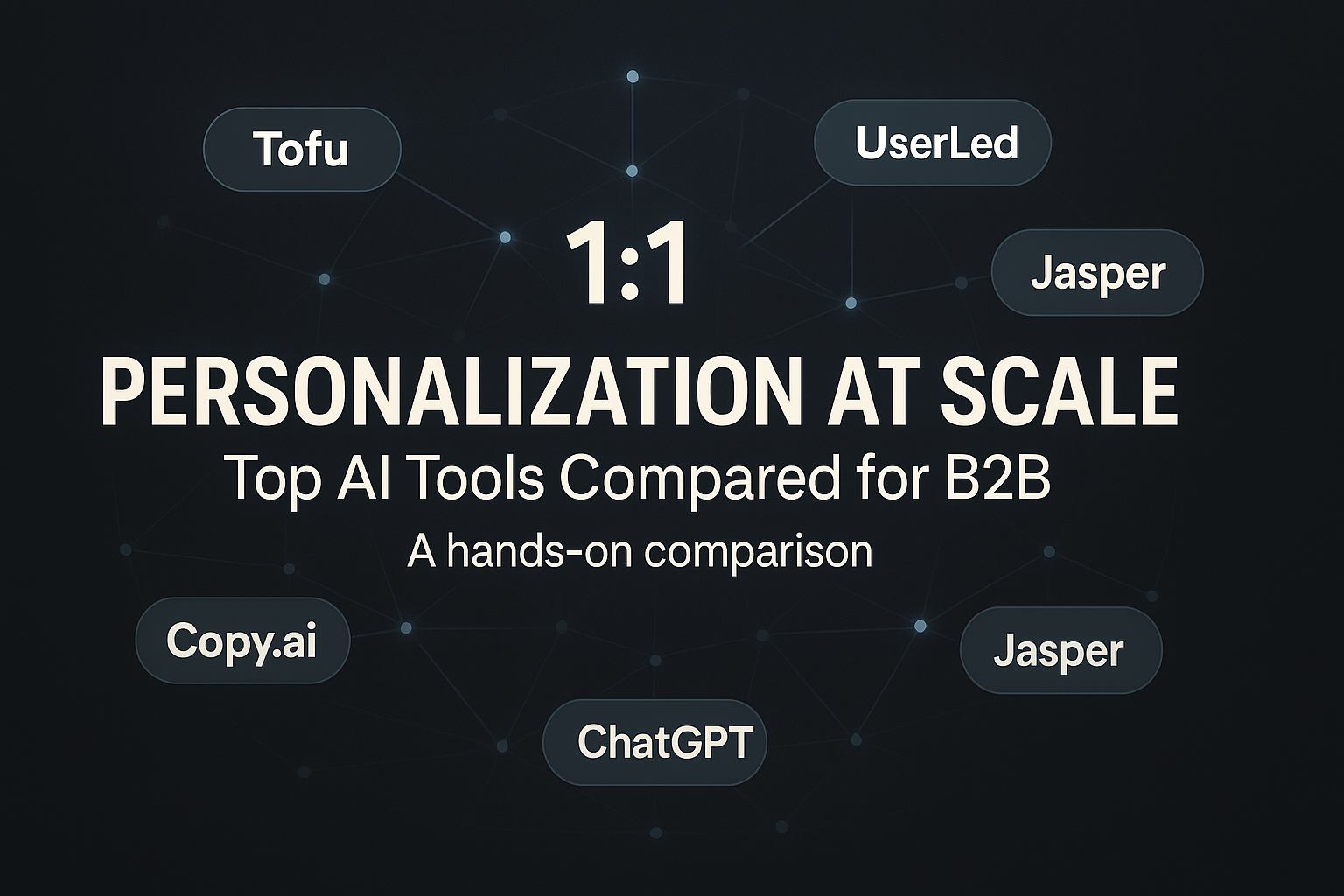
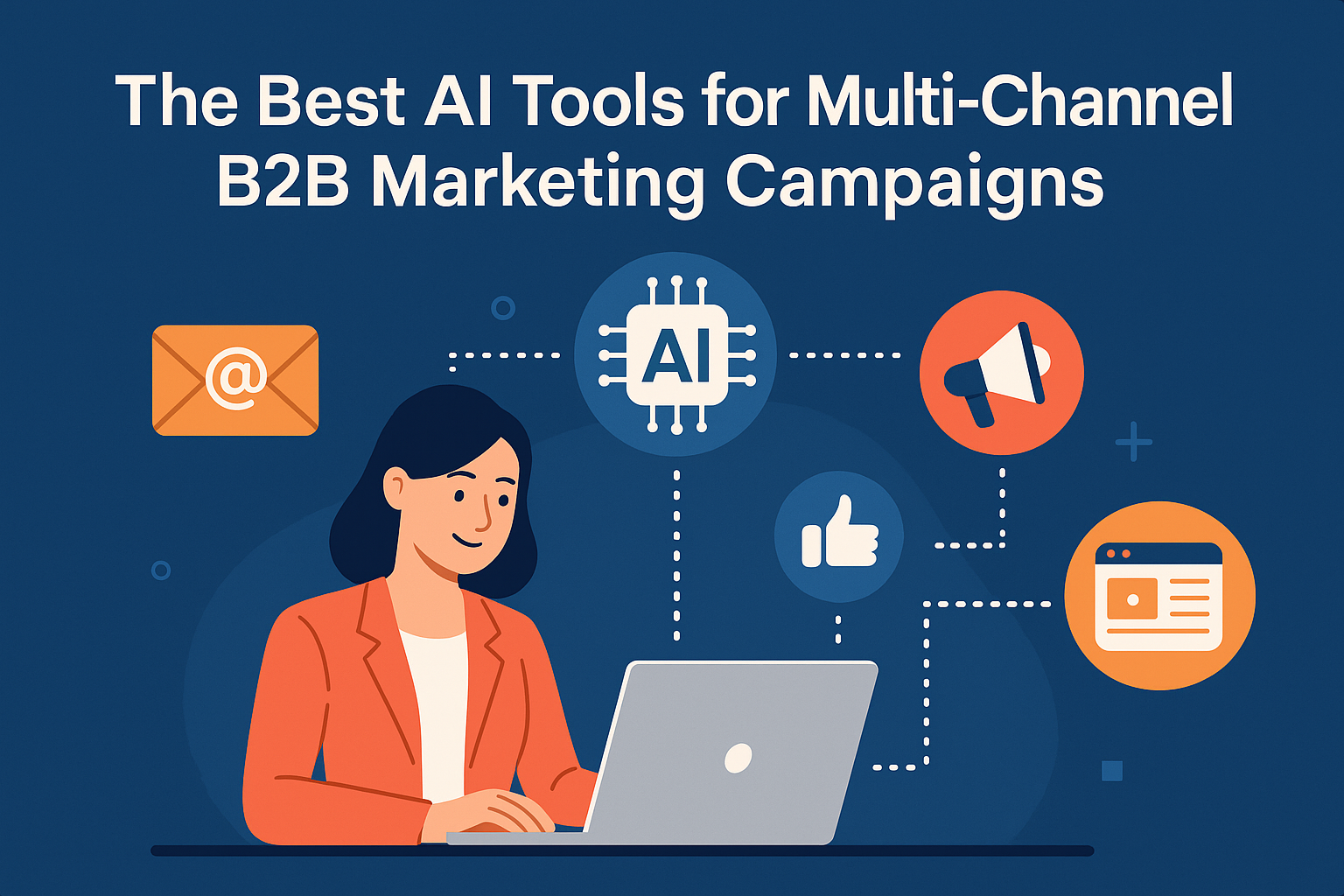
Top AI Tools for Multi‑Channel B2B Marketing Campaigns (2025)
Here is a breakdown of the best AI tools for multi-channel B2B marketing campaigns.
.svg)
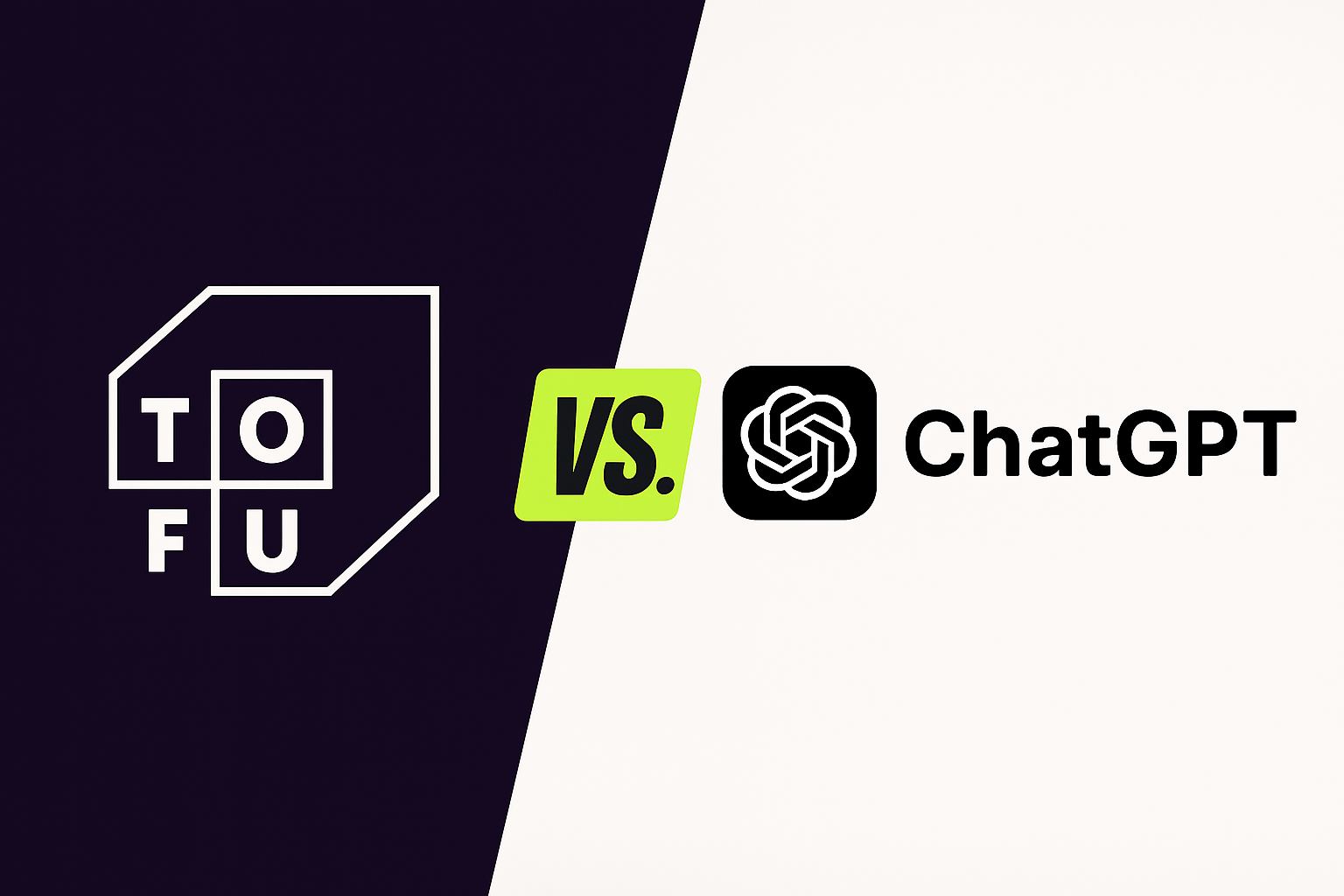
Tofu vs. ChatGPT: Which Should You Use for AI Marketing Campaigns?
For B2B marketers, generative AI is no longer optional—it’s essential. ChatGPT offers broad capabilities at a low cost. Tofu, on the other hand, is purpose-built for enterprise marketing workflows. Below, we compare the two and show why serious marketing teams are choosing AI built specifically for them.
.svg)
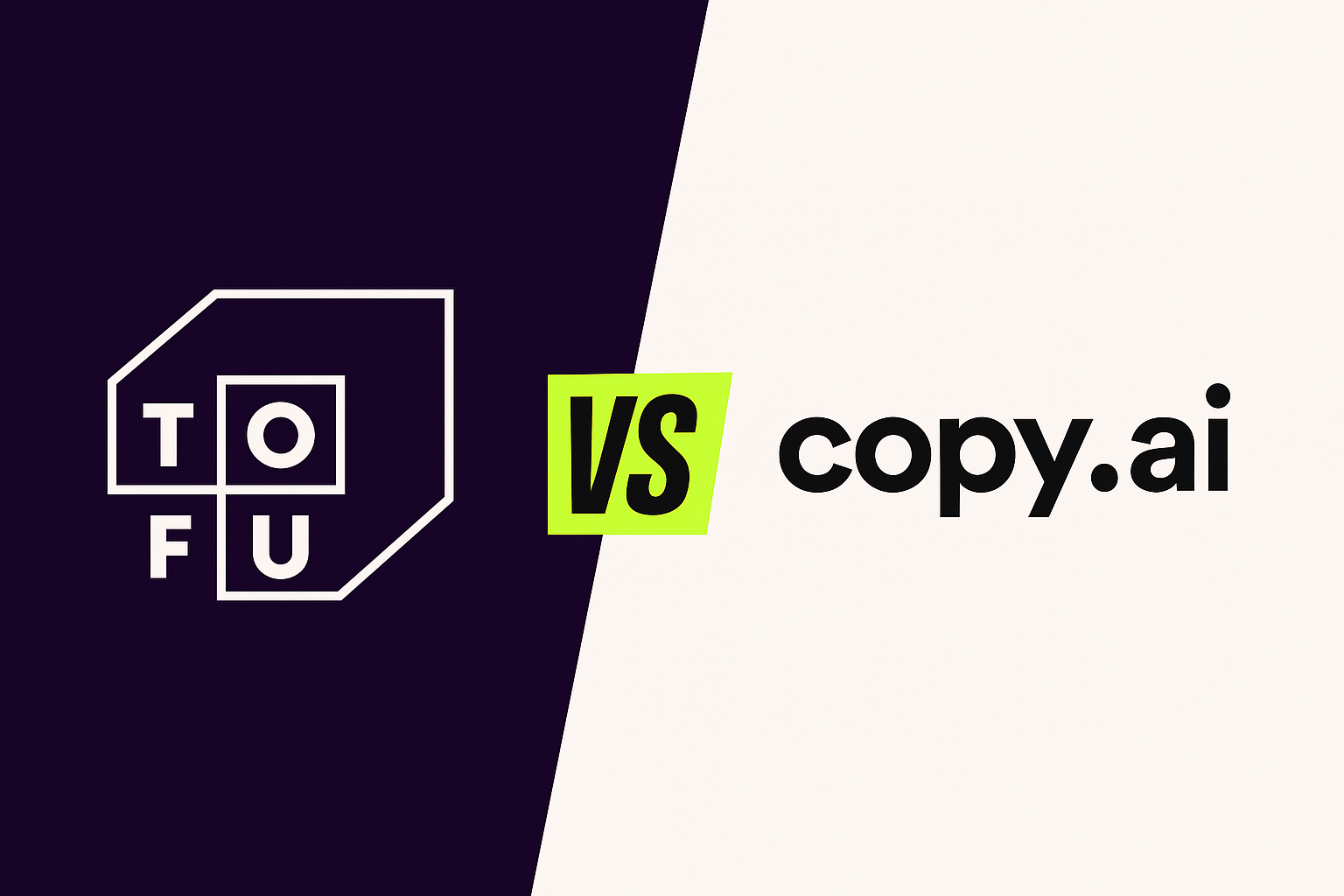
Tofu vs. Copy.ai: Which AI Marketing Platform Comes Out on Top?
Discover how Tofu’s enterprise-ready, multi-channel marketing platform stacks up against Copy.ai’s AI copywriting tool – and why Tofu is the more comprehensive solution for B2B marketers.
.svg)
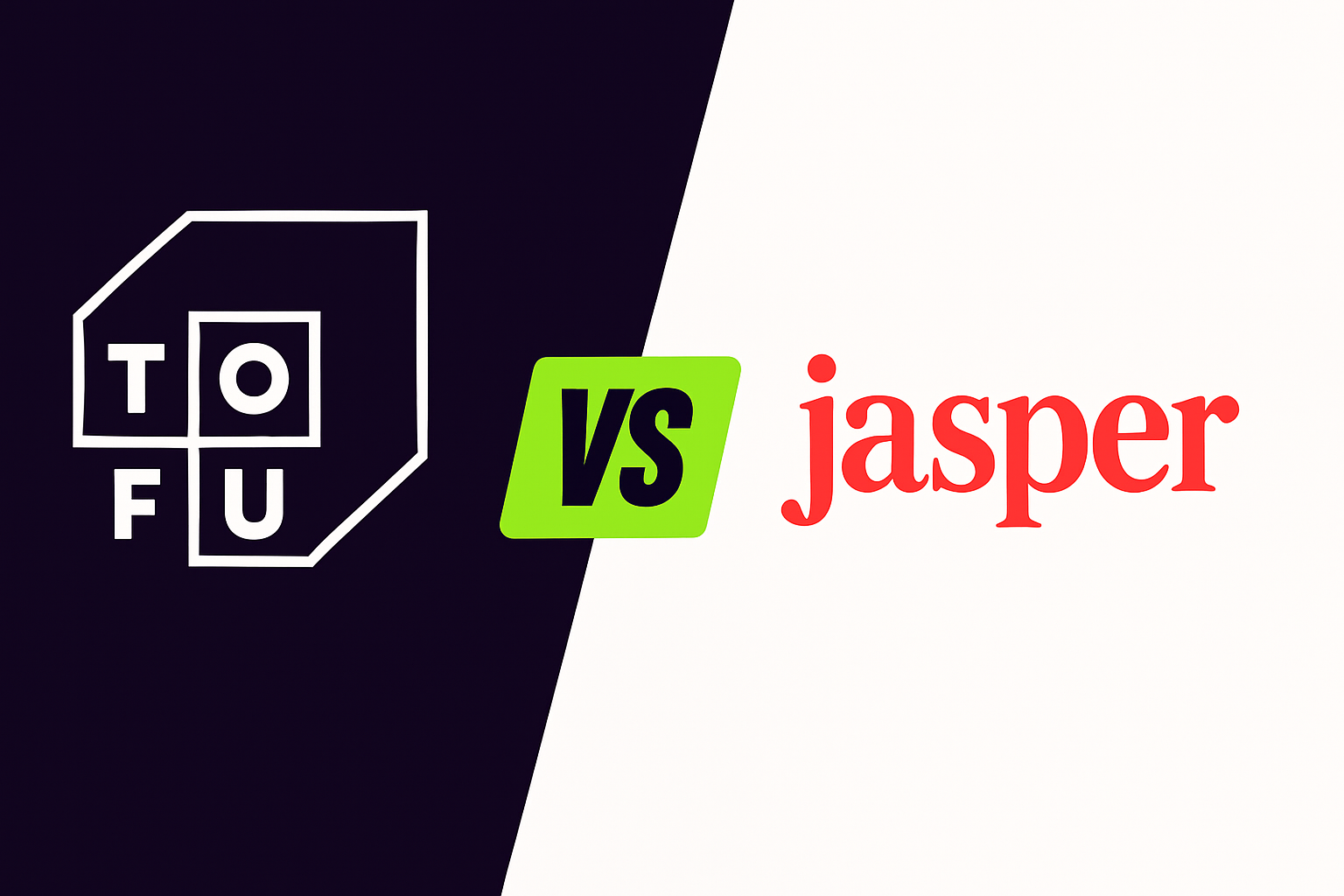
Tofu vs. Jasper: Which AI Marketing Tool is Best?
Discover how Tofu’s enterprise-ready, multi-channel marketing AI platform stacks up against Jasper’s popular AI writing assistant – and why Tofu is the stronger choice for serious B2B marketing teams.
.svg)
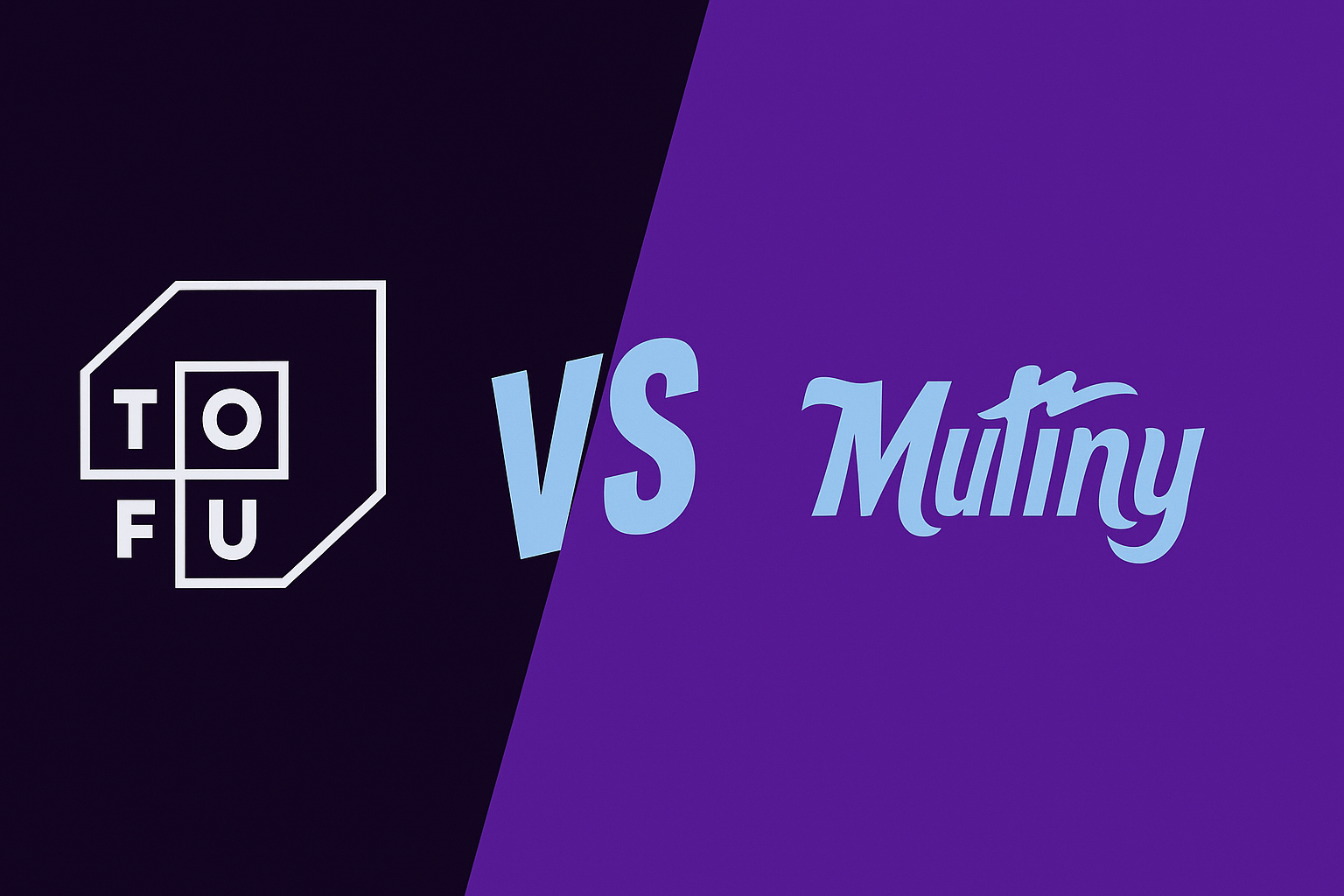
Tofu vs. Mutiny: Which is Best for ABM Campaigns?
Tofu vs Mutiny: Which ABM platform comes out on top? Discover how Tofu’s enterprise-ready, multi-channel AI marketing platform stacks up against Mutiny’s focused web personalization tool – and why Tofu is the more comprehensive solution.
.svg)
.png)
Tofu vs. UserLed: Which ABM Platform Should You Use?
Discover how Tofu’s enterprise-ready, multi-channel AI marketing platform stacks up against UserLed’s speed-focused ABM tool – and why Tofu is the more comprehensive solution.
.svg)

Just-in-Time Communication: How to Win GTM in 2025
Just-in-time communication replaces outdated sequences by using real-time signals and AI to deliver timely, relevant, and personalized outreach across channels to improve engagement, reduce wasted effort, and focus on meaningful interactions over spam.
.svg)

Mastering Marketing in 2025: What you need to know from 14 of the best
In 2024, we spoke with 14 of the best B2B CMOs and CROs. Here are their best tips, tactics, and guides to managing your GTM as you plan for 2025.
.svg)
Want to give tofu A try?
Request a custom demo to see how Tofu can supercharge your GTM efforts.
ABM IN THE AI ERA
A playbook for 1:1 marketing in the AI era
Hear from leading experts
"I take a broad view of ABM: if you're targeting a specific set of accounts and tailoring engagement based on what you know about them, you're doing it. But most teams are stuck in the old loop: Sales hands Marketing a list, Marketing runs ads, and any response is treated as intent."

"ABM has always been just good marketing. It starts with clarity on your ICP and ends with driving revenue. But the way we get from A to B has changed dramatically."
.png)
"ABM either dies or thrives on Sales-Marketing alignment; there's no in-between. When Marketing runs plays on specific accounts or contacts and Sales isn't doing complementary outreach, the whole thing falls short."

"In our research at 6sense, few marketers view ABM as critical to hitting revenue goals this year. But that's not because ABM doesn't work; it's because most teams haven't implemented it well."
.png)
"To me, ABM isn't a campaign; it's a go-to-market operating model. It starts with cross-functional planning: mapping revenue targets, territories, and board priorities."

"With AI, we can personalize not just by account, but by segment, by buying group, and even by individual. That level of precision just wasn't possible a few years ago."
%201%20(1).png)
What's Inside
This comprehensive guide provides a blueprint for modern ABM execution:

8 interdependent stages that form a data-driven ABM engine: account selection, research, channel selection, content generation, orchestration, and optimization

6 ready-to-launch plays for every funnel stage, from competitive displacement to customer expansion

Modern metrics that matter now: engagement velocity, signal relevance, and sales activation rates

Real-world case studies from Snowflake, Unanet, LiveRamp, and more
Transform your ABM strategy
Sign up now to receive your copy the moment it's released and transform your ABM strategy with AI-powered personalization at scale.
Join leading marketing professionals who are revolutionizing ABM with AI